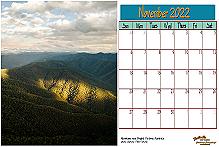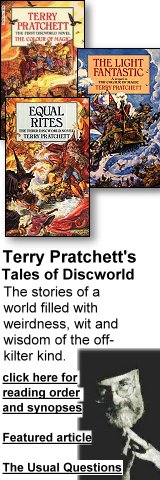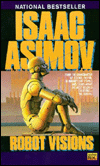Isaac Asimov Series Page
Foundation and Robots (page 2)
Volume 11 of the series brings us to the original Foundation.
All cover images on this page are from the Ali Kayn's collection and/or review copies.
The Foundation series was tied together by the theory of 'psychohistory', a system of methematics so complex that it could predict history.
Asimov also became the standard in robot stories, his Three Rules of Robotics were intergrated into the stories of other authors.
Not content with having such successful series as the Robots stories and the Foundation trilogy, Asimov, who prided himself on his hubris, set about tying them together.
This reading order is his own published chronology for the combined Robots and Foundation series.
All cover images on this page are from the contributor's collection and/or review copies.
submitted by Ali Kayn
Page 2 Foundation and Robots series
Summary:
I, Robot
The Rest of Robots
Caves of Steel
The Naked Sun (1956)
The Robots of Dawn (1983)
Robots and Empire (1985)
The Currents of Space (1955)
The Stars Like Dust (1955)
Pebble in the Sky (1950? 1958?)
Prelude to Foundation (1988)
Foundation
Foundation and Empire (1952)
Second Foundation (1953)
Foundation's Edge (1982)
Foundation and Earth (1986)
Forward the Foundation
Robot Dreams
Robot Visions

11. Foundation (1951), Isaac Asimov
| 11. Foundation (1951)
Originally published in the pulps, the foundation trilogy was based on the Rise and Fall of the Roman Empire timeline. Written when Asimov was but a callow youth, it isn't great literature, but it is a seminal work and a must-read for any science fiction fan.
The Old Empire is crumbling and Hari Seldon and his psychologists work to create the Foundation, dedicated to art, science and technology to be the nucleus of the next foundation, predicted to rise after the dark ages to come. Seldon believed that his work could considerably shorten the years of decay and barbarism to come. |
The Foundation members are dedicated to creating a repository of information. Over the years the Foundation continues to work on the great Encyclopedia Galactica but their trading is beginning to take precedence. Hober Mallow, the first Foundation Merchant Prince leads their development of the techniques of economic warfare.
A collection of four stories published between 1942 and 1944, plus an introductory section written in 1949. |
| Buy Online |
Amazon.com |
Amazon.co.uk | |

12. Foundation and Empire (1952), Isaac Asimov
|
12. Foundation and Empire (1952)
Originally two stories, published in 1945, this become the second part of one of the great SF trilogies. In the tradition of SF trilogies, of course, it went on ...
Hari's predictions are holding true until they encounter what cannot be predicted -- a mutation.
|
|
| Buy Online |
Amazon.com |
Amazon.co.uk |
|

13. Second Foundation (1953), Isaac Asimov
|
13. Second Foundation (1953)
Originally two stories published in 1948 and 1949 this volume .
The mystery continues, if Hari Seldon set up two Foundations, where is the second colony?
|
|
| Buy Online |
Amazon.com |
Amazon.co.uk |
|

14. Foundation's Edge (1982), Isaac Asimov
|
14. Foundation's Edge (1982)
Unlike the earlier novels, this is a great thumping book. This is the first book that Asimov wrote in which he brought together the Robots and the Foundation and Empire.
The Eternals, who adjusted human history appear in The End of Eternity which doesn't conform to this chronology.
The fifth Foundation novel if you count the prequel (Asimov did), my copy announces that it is the fourth, based on publishing dates.
|
|
| Buy Online |
Amazon.com |
Amazon.co.uk |
|

15. Foundation and Earth (1986), Isaac Asimov
|
15. Foundation and Earth (1986)
The search is on for the legendary planet, Earth. In Asimov's universe, humans will only grow if they leave the Earth, and that may require it's destruction. Of course, Asimov was afraid of flying, as you can tell from some of his writing, and catastrophe would probably have been necessary to get him into the air, much less space. (Another famous SF person afraid of flying was Stanley Kubrick).
|
|
| Buy Online |
Amazon.com |
Amazon.co.uk |
|

Forward the Foundation , Isaac Asimov
|
Forward the Foundation (Finale)
Hari Seldon, struggles with his greatest work on psychohistory in the fading light of a doomed empire.
Although this book is placed chronologically between 5 and 6, it is best read last.
|
|
| Buy Online |
Amazon.com |
Amazon.co.uk |
|















 Published in Melbourne, Victoria, Australia
Published in Melbourne, Victoria, Australia 